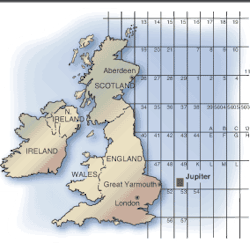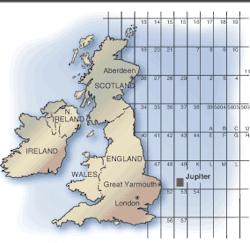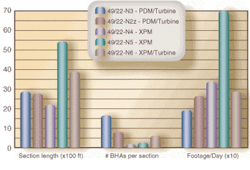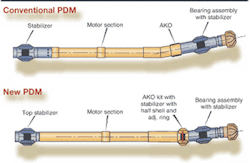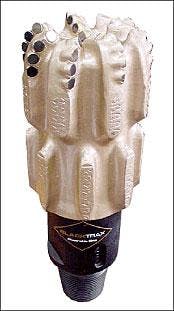A new generation positive displacement motor
J. Grindrod, C. Rayton, C. Sim,Baker Hughes Inteq
N. Biggs, A. Brown,Hughes Christensen
P. Taylor, Conoco UK Ltd
Wells in the Jupiter field, in the UK Southern North Sea, require rela-tively long (1,000-5,372 ft) horizontal 6-in. hole sections to be drilled through the Permian age, Rotlie-gendes sandstone reservoir. Tight target toler-ances on true vertical depth necessitate good directional control over the entire section length.
The technology combinations used to drill these sections typically were:
- High-speed turbines run in conjunction with polycrystalline diamond compact (PDC) drill bits or diamond impregnated bits
- Conventional low speed positive displacement motors (PDMs) coupled with both roller cone bits and PDC bits.
Drilling with turbines resulted in heavy drill bit wear, due to high rotational speeds, and required significant periods of orientation to combat the inherent left hand walk tendencies of the assemblies. Conventional PDM and roller cone assemblies gave rise to multiple trips due to bit bearing life limitations on run length. The problems of erratic PDC bit torque and stalling of conventional motors because of variable weight transfer coupled with motor torque output limitations made attempts to use this combination unsuccessful.
The development of a new generation PDM that was able to produce significantly more power and torque than conventional motors, at comparable bit speeds, was introduced to overcome these problems. Compared with turbines, the new generation Extra Power Motor (XPM) was found to be easier to control, monitor, and optimize, as both revolutions per minute (rpm) and power output are directly proportional to drilling fluid flow rate and motor differential pressure, respectively.
In conjunction with the new XPM technology, application-specific PDC bits featuring a unique tandem gauge were designed to maximize hole quality and therefore provide more even weight transfer to the bit. This, combined with an optimized PDC cutting structure, facilitated smooth torque output at the bit-rock interface and so supported the use of the new motor technology.
Application
The application of the XPM and application-specific PDC technology were implemented in drilling a series of 6-in. hole sections in Conoco's Jupiter field in block 49/22 in the UK Southern North Sea.
The reservoir rock in this field is the Leman sandstone formation, part of the Permian age desert-facies Rotleigendes Group, located toward the southwestern margins of the Southern Permian basin. Overlying this is a sequence of Permian age Zechstein carbonates and evaporites, consisting of interbedded units of anhydrite, dolomite, halite, and limestone.
The 6-in. hole sections on wells 49/22-N3 and N2z were drilled with conventional turbine and PDM technology. Three 6-in. hole sections on wells N4, N5, and N6 were drilled predominantly with XPM technology between May 1999 and November 2000. Typically, these sections were drilled out from a 7-in. 32-ppf HC110 liner with the shoe set in the basal Zechstein Werraanhydrit formation. Well profiles varied depending on the specific target locations, but were typically planned to reach 90° by total depth of the 8 1/2-in. hole. The 6-in. sections were then drilled for the most part horizontally, predominantly through the Leman sandstone.
Historical performance
The 6-in. hole sections in the 49/22-N2z and N3 wells were drilled using turbine and conventional PDM technology combined with diamond-impregnated PDC and tungsten carbide insert drill bits. On the N3 well, a variety of assembly stabilization configurations were used, depending on the requirement to build or drop. Slick assemblies with large PDM tilt angles were used to drop the angle.
When this approach failed, the assemblies were made-up with adjustable stabilizers to run full-gauge to hold the angle and under-gauge to drop the angle. The assemblies in the N2z well were run slick. This bottom hole assembly (BHA) configuration was chosen to improve weight transfer to the bit by eliminating the possibility of stabilizer hanging up.
Turbine technology
Historically, diamond-impregnated bits and turbines have been used to drill the abrasive Leman sandstone in the UK Southern North Sea. Due to their relatively low depth of cut, these bits require a high rpm to achieve good penetration rates.
The operating principles of a directional turbine are based on impact of the drilling fluid on the turbine blades. Both the power and torque output depend on the flow rate, mud density, turbine blade angle, and the number of turbine stages in the tool. Reducing the fluid density results in a loss of the maximum power output.
Torque output and rpm are inversely proportional to one another, with the maximum torque achieved at the stall point of the turbine, and maximum rpm occurring when the tool is rotating off bottom (run-away bit speed). The optimum power output is achieved at half the off-bottom rpm and half the stall torque.
In this situation, the thrust applied to the axial bearings from the fluid flow through the turbine is balanced by the weight on bit (WOB). Under these circumstances, the turbine will output maximum power while reducing the wear on the axial bearings. Variation in rpm can be monitored at surface using the differential pressure across the tool (the difference in pressure drop across the tool when off or on bottom). This can be difficult to do, as the difference in pressure loss over the entire rpm range is generally small. Fluctuations in bit rpm result in a variable power output and can have a negative impact on drilling performance.
Utilizing turbine technology places other operational constraints on drilling operations. The bit type is limited to those designed to maintain low-pressure drops. Higher system pressure drops are required to achieve optimum power and torque output than with a PDM. Lost circulation material (LCM) cannot be pumped through the tools, due to the risk of blockage and accelerated wear on the turbine stack. While drilling with a stabilized turbine in rotary mode, the azimuth control can be impaired with a left-hand walk. This can result in relatively large percentages of oriented drilling, reducing the overall drilling performance and increasing the overall tortuosity of the well bore.
PDM technology
To overcome some of these operational limitations, particularly in horizontal wells with tight directional tolerances, the requirement to produce high bit rpm can be met with the PDM or "Moineau motor." These tools work on the progressive cavity principal. Fluid is pumped into the cavity formed between the rotor and stator. The force imparted causes the rotor to be turned inside the stator and the drilling fluid passes through the power section as the cavity moves progressively down the tool. The power output and torque are directly proportional to the differential pressure across the PDM and are not affected by variations in fluid density. This parameter can be monitored at the rig floor, and be used to finely adjust power and torque output to the bit while drilling.
Other advantages of the PDM are that pump pressures required are much less than needed to run a turbine. A higher-pressure loss can be maintained across the bit, allowing for the use of a greater range of bit styles. LCM can be pumped through the tool when required. Finally, the tool is cheaper to build and maintain, as well as easier to redesign to alter the power output and bit rpm.
Standard PDMs suffered from a number of disadvantages. Due to the large amount of rubber used in the construction of the stator, the operating down-hole temperature is significantly less than a turbine. While drilling extended-reach and horizontal holes in oriented mode, tool face control can become problematical, as the torque generated at the bit can be greater than the power output of the motor. Under these circumstances, the motor would stall and interrupt the drilling process. A new stator manufacturing technology was developed to overcome these limitations.
New drilling motor
The new generation performance motors, such as the XPM, incorporate significant changes in power section, adjus-table kick-off (AKO), and bearing assembly design compared with existing PDMs. Addi-tionally, the steering concept is altered by stabilization changes and steering head design modification.
The power section features a precision-milled contoured internal steel stator surface laminated with a thin layer of elastomer. This reduces the thickness of stator rubber compared to standard motors. This design gives a much greater control of the fit between rotor and stator and eliminates the potential for stator deformation. The tighter tolerances and reduced stator deformation result in improved motor efficiency, increased power output, and a broader overall operating range (flow rate to torque regime).
Drilling performance
To maximize the drilling performance, it is critical that the percentage of off-bottom time is kept to a minimum. A PDC bit drills by shearing and scraping the formation. The reactive torque generated by the cutting mechanism can have a detrimental effect on the orientation of the tool face. Time spent adjusting tool face as a result of the WOB fluctuations, restarting after motor stalls, and correcting well path deviations all compromise the rate of penetration (ROP).
By reducing the aggressiveness of the cutting structure, the reactive torque of a PDC bit is reduced, but the net ROP will also suffer. A unique PDC bit was designed for the N4 well to improve the net penetration rate without compromising tool face control. Unaggressive cutters placed in the cone allow the WOB fluctu- ations to be absorbed without a commensurate increase in the torque response of the bit.
In addition to the steerable cutting structure, the PDC bit had an extended dual-gauge configuration designed to provide increased borehole wall contact and help remove the formation ledges that occur when changing between orientation and rotation modes of drilling. The net effect of the dual-gauge is to ensure very high quality borehole geometry.
Conclusions
Innovative motor design, resulting in much greater internal efficiency, has provided higher power and torque output levels. This has enabled, for the first time, the effective use of PDC drill bits in drilling horizontal sections in the Rotliegendes formation.
Innovative PDC drill bit technology, matched to both application and drive system, facilitated the successful introduction of the new XPM technology.
Overall, the use of these new technologies has provided much better control over the drilling process when compared with historical performance. Specifically, higher ROP, minimal orientation required, less likelihood of stalling and consequently better control of tool face. The result was a step change in drilling efficiency.
Acknowledgments
The authors would like to thank Conoco UK Ltd., Baker Hughes Inteq, and Hughes Christensen for their permission to publish this paper.
